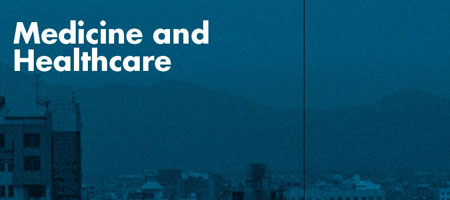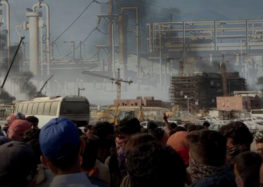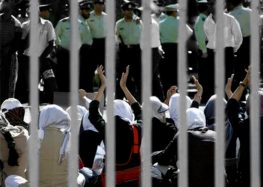Medicine and Healthcare
 A Growing Crisis: The Impact of Sanctions and Regime Policies on Iranians’ Economic and Social Rights
A Growing Crisis: The Impact of Sanctions and Regime Policies on Iranians’ Economic and Social Rights
Medicine and Healthcare
Crucially, the combination of sanctions and mismanagement has also reduced the availability and quality of medication and medical devices, and increased the cost of receiving treatment, especially for life-threatening and incurable ailments. As a result, the quality and accessibility of healthcare has plummeted.
According to a letter signed by the presidents of all of Iran’s medical universities addressed to Behrooz Moradi, Ahmadinejad’s deputy for planning, the rate of inflation in Iran’s medical sector was running at 350 percent in late 2012.[200] At roughly the same time, the head of the Majlis’ Health Committee, Hossein Ali Shahriari, referred in a Radiofarda report to the “catastrophic” conditions in the pharmaceuticals market, drawing his colleagues’ attention to reports of exorbitant prices, the dearth or disappearance of a large number of medications, and the long and useless lines in pharmacies and the black market.[201]
Several factors account for this state of affairs. According to an informed pharmacist in Iran, roughly 97 percent of the nation’s requisite annual medication is produced internally by Iranian pharmaceutical companies.[202] However, Iranian pharmaceutical companies are dependent on imported ingredients for 80 percent of the raw materials they utilize to manufacture their products.[203] While Iranian pharmaceutical companies are able to produce “the generic versions of brand-named pharmaceuticals,” they are unable to manufacture “the most advanced drugs that have come to the market over the past 10 to 15 years that deal with a variety of serious illnesses, simply because their generic versions are not yet available.”[204] The drugs that Iran imports, therefore, are used to treat life-threatening and incurable diseases, such as a variety of cancers, AIDS, hemophilia, thalamassia, multiple sclerosis, and heart and kidney disease. According to the statistics put out by the Iranian Ministry of Health, there are presently six million patients in Iran who are afflicted with such diseases.[205] Moreover, Iran is dependent on imports for virtually the entire stock of its medical equipment and machinery.
US and EU officials say the sanctions are not meant to harm the general population. The Wall Street Journal cites David Cohen, US Undersecretary of Treasury, as saying, “Sanctions do not cover the importation of food, medicine, or medical devices. . . . This has been a long-standing policy of the US.” In the same article, a spokesperson for Catherine Ashton, the EU Foreign Affairs Commissioner, is quoted as saying, “Our sanctions are targeted with relevant exemptions to minimize, as much as possible, unintended consequences on the population.”[206] However, with such an overdependence on imports, sanctions have played a critical role in the increased unavailability of medicine, as well as the rise in the prices of medication and healthcare in Iran, with direct consequences for the Iranian population.
Indeed, officials at NGOs and Western pharmaceutical companies, ranging from UN Secretary General Ban Ki-moon to a spokesperson for Roche, have asserted that Iran’s expulsion from SWIFT plus a plethora of other banking and financial sanctions are interfering with the transport of medicine and medical equipment into Iran. According to Ban Ki-moon, as quoted in Al-Monitor, “there is a shortage of drugs used to treat cancer, heart and respiratory conditions and multiple sclerosis, among other conditions because foreign drug companies can no longer figure out how to get paid through the international financial system.”[207] Valiollah Seif, managing director of a private bank in Iran that has not yet been sanctioned by the US, stated in another Al-Monitor article, “there exists no banking channel for payments to pharmaceutical suppliers in Europe and America. The most vital drugs for cancer and other severe diseases are now being denied to the Iranian population by European manufacturers due to the lack of appropriate banking channels.”[208]
Adding credence to these claims, research by the BBC Persian Service indicates that the level of exports to Iran by European pharmaceutical companies had declined by 30 percent in the five months leading to January 2013. Moreover, the pharmaceutical giant Roche has told the BBC that the opening of letters of credit (LCs) or even cash payments have become exceedingly difficult, resulting in long delays in transporting medicine to Iran.[209]
While sanctions have impeded Iran’s ability to access critical medical supplies, the role of internal factors in contributing to the unfolding health crisis in Iran should not be overlooked. According to the Health Commission of the Iranian Majlis, the subsidy rationalization program, the government’s failure to allocate to the healthcare sector its share of the savings from the subsidies reform program, and the government’s failure to allocate a significant amount of hard currency at the lowest subsidized rate to the Ministry of Health, have all contributed greatly to the health crisis in Iran.[210] As with other industries, the pharmaceutical sector in Iran was not compensated for the rise in energy and utilities costs that resulted from the rationalization of subsidies. Moreover, the pharmaceutical industry, like other sectors, is having great difficulty receiving loans from Iranian banks.[211]
The most egregious internal factor contributing to the dearth of medicine and medical supplies was summed up by the former minister of health in the Ahmadinejad administration, Marzieh Vahid Dastjerdi, who publicly said before she was abruptly relieved of her post, “Our problem is transfer of money out of the country and also internally the problem of funds allocation from the central bank. We circumvent the external problems through unconventional means (establishing companies in third countries such as Turkey, using their banking system to transfer funds, having goods delivered to Turkey, re-exporting to Iran, and passing the additional costs to Iranian customers and patients). But we cannot circumvent the issue of fund allocation from the central bank.”[212] Dastjerdi went on to say that the central bank had allocated only a third of the $2.5 billion needed by Iranian importers of medicine for the Iranian year beginning on March 21, 2012, and that this money had only been released after September.[213] Thereafter, Hassan Tamini, Deputy Head of the Health Commission in the Majlis, stated that “due to the reduction of the primary [imported] ingredients of medicine, domestic pharmaceutical companies have encountered difficulties manufacturing their products. . . . It is unclear why the central bank remains uninterested in resolving this issue.”[214] At the same time, the Arman newspaper revealed that the government had also not allocated $650 million for the import of essential medical equipment.[215] To clarify that these neglects were not due to lack of resources, Hossein Ali Shahriari, Head of the Majlis Health Committee, and Ahmad Tavakoli, former Head of the Research Unit of the Majlis, revealed that the subsidized funds that should have been allocated to the Ministry of Health had instead been spent on the import of shovel handles, saddles, and luxury cars, including Porsches and Maseratis.[216]
Also undermining the Iranian people’s right to healthcare is the response of Iranian insurance companies to the health crisis. Because of the increase in the price of medication and medical equipment, all insurance companies, public and private, have passed on an increasing share of the cost of treatment and medicine to the patients themselves.[217] Estimates and figures vary, but according to the Ministry of Health, patients now have to pay between 50 and 70 percent of the cost of treatment.[218] The representative of Lankroud to the Majlis, meanwhile, has asserted that 80 percent of healthcare expenses have fallen on the shoulders of patients.[219] Regardless of which figure is correct, all of the above figures represent a severe health crisis for the Iranian population. In August 2011, before the problems confronting the Iranian healthcare industry reached their present state, Massoud Javanbakht, a member of the Physician’s Association of Iran, asserted that only 25 percent of Iran’s 75 million population were capable of paying the heavy expenses of hospitalization.[220]
Indeed, due to high expenses, a growing proportion of Iranians suffering from terminal and incurable diseases are choosing to stop treatment. In December 2012, Hossein Ali Shahriari, the chair of the Majlis’ Health Committee, claimed that the cost of one phase of cancer treatment had risen from 500-600 million rials to 2 billion rials in the course of one year—“telling [in effect] the majority of these patients to go and die.”[221] A cancer patient confided to a BBC Persian reporter, “I would rather die, and not impose so much burden on my family.”[222]
[200] “Medical School Chancellors Write Letter of Protest to Vice President: Cost of finished goods for medicine and medical consumables has risen by 350%,” Fararu Website.
[201] Fahimeh Khezr Heydari, “The Catastrophe of Medicine In Iran,” Radiofarda, December 1, 2012.
[202] International Campaign for Human Rights in Iran interview with an Iranian pharmacist on October 1, 2012.
[203] “90 Drugs Cannot Be Found On the Iranian Market: The Inhumane Impact of Sanctions and the Exchange Rate On Iran’s Pharmaceutical Market,” Tejarat News, October 13, 2012.
[204] Muhammad Sahimi and Eskandar Sadeghi-Boroujerdi, “The Unfolding Human Catastrophe In Iran,” Aljazeera, October 28, 2012.
[205] “Challenges of Importing Medicine Into Iran,” VOA Persian, December 17, 2012.
[206] Benoit Faucon, “In Iran, Private Sector Feels Squeeze of Sanctions,” Wall Street Journal, August 2, 2012.
[207] See Barbara Slavin, “US Looks to Renew Iran Talks After the November Elections,” Al-Monitor, October 8, 2012.
[208] See Barbara Slavin, “Iranian Charity and Banker Say US Sanctions Hurting Patients,” Al-Monitor, August 15, 2012.
[209] Fariba Sahraiee, “Sanctions and Medication, An Incurable Pain,” BBC Persian, January 19, 2013.
[210] Fahimeh Khezr Heydari, “The Catastrophe of Medicine in Iran,” Radiofarda, December 1, 2012.
[211] “The Government’s 750 Trillion Rial Debt To Medicine Distribution Companies,” Radiofarda, September 23, 2012.
[212] “Challenges of Importing Medicine into Iran,” VOA Persian, December 17, 2012.
[213] Ibid.
[214] “The Government’s $2 Billion Debt For Importing Medicine,” Radiofarda, October 29, 2012.
[215] Ibid.
[216] See “Tenfold Increase In Bank’s Non-Performing Loans, Sources of Emulation Worry About Start of Social Revolts,” Radiofarda, December 30, 2012. See also “Rumors About Sacking of the Health Minister , Revelations About Allocation of Medicine Funds To Saddles,” Radiofarda, December 15, 2012.
[217] “Sanctions That Transform Medicine Into Gold,” BBC Persian, July 27, 2012.
[218] “Challenges of Importing Medicine Into Iran,” VOA Persian, December 17, 2012.
[218] Fahimeh Khezr Heydari, “The Catastrophe of Medicine in Iran,” Radiofarda, December 1, 2012.
[220] “Head of Iran’s Physician’s Order: Inflation In the Health Sector Is More Than 40 Percent,” Radiofarda, July 11, 2012.
[221] “Challenges of Importing Medicine Into Iran,” VOA Persian, December 17, 2012.
[222] “Sanctions That Transform Medicine Into Gold,” BBC Persian, July 27, 2012.






